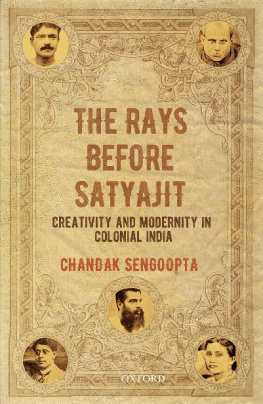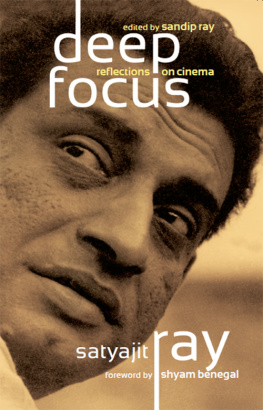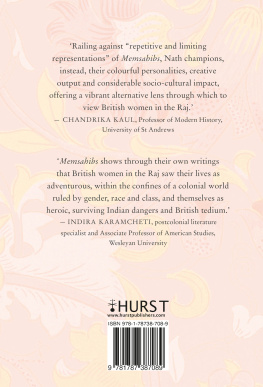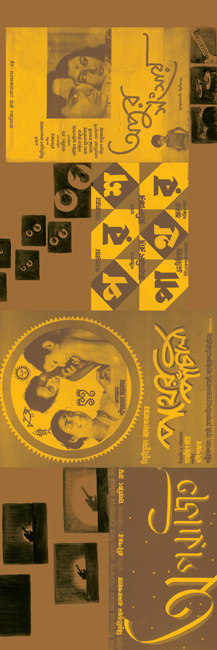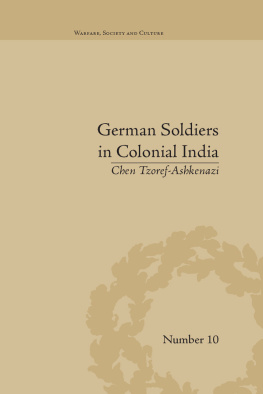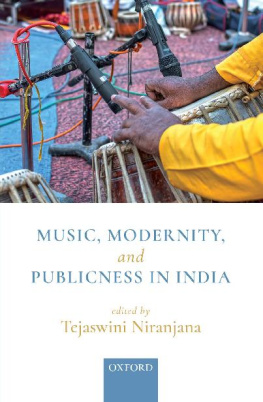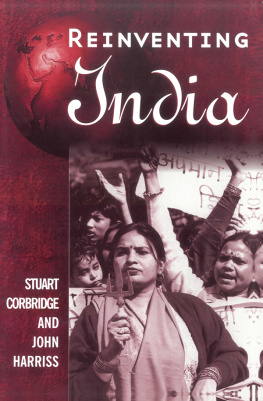The Rays before Satyajit
The Rays before Satyajit
Creativity and Modernity in Colonial India
Chandak Sengoopta
Oxford University Press is a department of the University of Oxford.
It furthers the Universitys objective of excellence in research, scholarship,
and education by publishing worldwide. Oxford is a registered trademark of
Oxford University Press in the UK and in certain other countries.
Published in India by
Oxford University Press
YMCA Library Building, 1 Jai Singh Road, New Delhi 110 001, India
Oxford University Press 2016
The moral rights of the author have been asserted.
First Edition published in 2016
All rights reserved. No part of this publication may be reproduced, stored in
a retrieval system, or transmitted, in any form or by any means, without the
prior permission in writing of Oxford University Press, or as expressly permitted
by law, by licence, or under terms agreed with the appropriate reprographics
rights organization. Enquiries concerning reproduction outside the scope of the
above should be sent to the Rights Department, Oxford University Press, at the
address above.
You must not circulate this work in any other form
and you must impose this same condition on any acquirer.
ePub ISBN-13: 978-0-19-908964-2
ePub ISBN-10: 0-19-908964-7
Typeset in ScalaPro 10/12.4
by The Graphics Solution, New Delhi 110 092
Printed in India at Rakmo Press, New Delhi 110 020
In memory of Nirmalya Acharya, Ekshan , and those Coffee House days
Contents
This book emerged unexpectedly while I was working on a biography of Satyajit Ray funded by the Leverhulme Trust, UK, and supported by my colleagues at Birkbeck College, especially Miriam Zukas, Julian Swann, Naoko Shimazu, Sunil Amrith, and John Arnold. Henriette Bruun and Dan Todes gave me wise advice and Partha Chatterjee, Partha Mitter, and Suranjan Ganguly provided much support. I shall be forever in their debt.
I am deeply grateful to the editors at Oxford University Press for the interest they took in the project, to the two anonymous reviewers who offered many suggestions for improving the manuscript, to Pinaki De for the excellent cover, and to Indrani Majumdar for making it all possible. As the book goes to press, I think of Nirmalya Acharya, whose untimely death robbed me of an inspiring and affectionate mentor, Bengal of an exponent of the highest type of adda , and the world of a scholar-editor of the kind they just do not seem to make any more. The Rays before Satyajit is dedicated to his memory and that of Ekshan , the magazine to which he dedicated his very life and which has never had an equal.
It has been an exciting book to write and I was helped along constantly by colleagues and friends, often through email or Facebook but also directly, during three long trips to Kolkata. Punam Zutshi and Ujjal Chakraborty had, at different times, encouraged me to write a biography of Satyajit Ray and the idea was warmly supported by Sandip, Lolita, and Souradeep Ray. They allowed me full access to the Ray family archives and I was guided through it first by Ujjal himself and then by Kaushik Ghosh and the incomparable Ramesh (Punu) Sen. Working in Satyajit Rays famous studywhich I had had the good fortune to visit in Rays lifetime for some brief but unforgettable conversationswas as exciting as it was nostalgic, and the archival discoveries that awaited me there were truly extraordinary. My thanks, too, to Arup K. De and the Ray Society for their support.
Those who have worked on any aspect of Indian or Bengali history would know that published sources are often as hard to find as archival material but thanks to the generosity of Debasis Mukhopadhyay, Riddhi Goswami, Biswajit Mitra, Indrani Majumdar, Debjani Ray, Sourit Dey, Debasish Deb, Amit Das, Anikendra Home, Syamantak Chattopadhyay, Sarbajit Mitra, and Arunkumar Roy, the task was less arduous than it might have been. I would also like to salute the work of the late Siddhartha Ghoshhis research on the Ray family was path-breaking in its time and it is lamentable that his essays and books have never been translated into English. Those who look at my notes will realize how indebted I am to his pioneering work and if, in my analyses, I differ from him, I do so with the most profound respect.
Paroma Maiti, an exemplary research assistant, worked harder on the project than I ever did, and even subjected herself and her ever-cheerful partner, Sourya Deb, to an agonizing trip in order to locate a particularly scarce periodical. My own travels were rather more pleasant, especially a trip to Santa Cruz, California, where Dilip Basu and Dayani Kowshik Basu guided me through the remarkable Lethbridge Collection of the Ray Film and Study Center at the University of California, Santa Cruz. I am thankful also to my sister, Anuradha (Bula), for sending many books and references from Kolkata.
I owe very special thanks to Soumen Paul for presenting me with innumerable books, periodicals, and photocopies that I could never have found by myself and for being such an unfailingly reliable source of information on graphic design, publishing, and every aspect of the book-world of Kolkata. He reminds me often of the late, greatly missed Indranath Majumdar, who had lightened the loads of generations of scholars and who passed away just as I was beginning to work on this project. Barun Chattopadhyay, who is himself working on a comprehensive biography of Dwarakanath and Kadambini Ganguli, led me to sources and issues that were new to me, providing me with beautifully scanned electronic copies of innumerable essential but scarce documents. Addas with him taught me more about historical research, Bengali society, human warmth, and collegial generosity than I could ever hope to list, and the chapters on Dwarakanath in this book could not have been written without his help.
Many colleagues, from near and far, offered encouragement, support, and intellectual inputs over the years it took me to finish the study. Satadru Sen alerted me to topics I had been utterly ignorant of; Ben Zachariah taught me not to turn everything into the history of nationalism; Manjita Mukharji, Sunil Khilnani, Jon Wilson, Ranjan Ghosh, Mark Mazower, Paul Lay, and the late Christopher Bayly got me to write or present papers that helped me clarify my ideas about the Rays; Behroze Gandhy and the British Film Institute invited me to teach a four-week course on Satyajit Rays cinema that gave me an opportunity to test out my arguments on a diverse and articulate group of students; Madhubanti Bhattacharyya showed me how to edit my imperishable prose; Pam Cullen, Kitty Cooper, Devika Banerjee, Shyamal Choudhury, and others at the Satyajit Ray Foundation helped me understand the intricacies of doing film history in the UK; Anindita Ghosh showed me how to find the hidden gems of the British Librarys Bengali collections, and the staff of the Rare Books and Music Reading Room put up cheerfully with the endless book requests that I then proceeded to place; and Saumitra SenGupta and Ilana Glaun, with characteristic wit, warmth, and panache, took me on an enthralling ride in San Francisco and Santa Cruz.
Swati Ganguly, Jayita Sengupta Sen, Shoubhik Sen, Sagnik Chatterjee, Alakananda Bhattacharya, Anuradha Chaudhuri, Sarbari Ghosal, Sayantani Adhikary, Arnab Dutta, Anirban Bandyopadhyay, Titas De Sarkar, Amit Das, Sanghita Nath, Sriparna Barman Bhattacharya, Kaushik Majumdar, Debajyoti Guha, Natsu Hattori, Misa Hanrath, and Sreeparna Mitra kept up my spirits with banter, books, drinks, laughter, gifts, food, and adda, while Priyamvada Gopal earned my undying gratitude by introducing me to Grumpy Cat. My warm thanks, too, to Madhab Mondal, the staff of Fanindra Guest House and of La Zeez (especially Pranab Chanak) for making my Kolkata trips so comfortable.



